Harm caused by Marine Litter
An overview on negative impacts caused by marine litter
Marine litter can impact organisms at different levels of biological organization and habitats in a number of ways namely: through entanglement in, or ingestion of, litter items by individuals, resulting in death and/or severe suffering; through chemical and microbial transfer; as a vector for transport of biota and by altering or modifying assemblages of species. Marine litter is a threat not only to marine species and ecosystems but also carries a risk to human health and has significant implications to human welfare, impacting negatively vital economic sectors such as tourism, fisheries, aquaculture or energy |
supply and bringing economic
losses to individuals, enterprises and communities.
This technical report aims to provide clear insight about the major negative impacts from
marine litter by describing the mechanisms of harm. Further it provides reflexions about
the evidence for harm from marine litter to biota, while also considering the socioeconomic effects, including the influence
of marine litter on ecosystem services.
General conclusions highlight that understanding the risks and uncertainties with regard
to the harm caused by marine litter is closely associated with the precautionary
principle. The collected evidence in this report can be regarded as a supporting step to
define harm and to provide an evidence base for the various actions needed to be
implemented by decision-makers. This improved knowledge about the scale of the
harmful effects of marine litter will further support EU Member States (MSs) and
Regional Seas Conventions (RSCs) to implement their programme of measures, regional
action plans and assessments. |
General conclusions highlight that understanding the risks and uncertainties with regard to the harm caused by marine litter is closely associated with the precautionary principle. The collected evidence in this report can be regarded as a supporting step to define harm and to provide an evidence base for the various actions needed to be implemented by decision-makers. This improved knowledge about the scale of the harmful effects of marine litter will further support EU Member States (MSs) and Regional Seas Conventions (RSCs) to implement their programme of measures, regional action plans and assessments. |  Northern Gannet (source: Nils Guse). |
 Ghost net snags on the violescent sea-whip (Paramuricea clavata) (source: Marco Matiddi). |  Average plastic abundance in a Fulmar stomach (left) and upscaled to the human scale (right). (source: Jan van Franeker –IMARES). |
